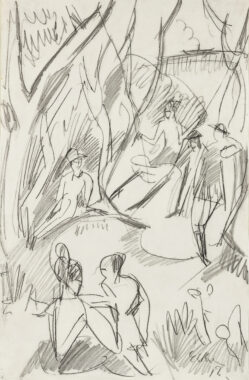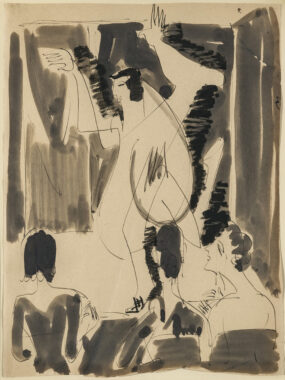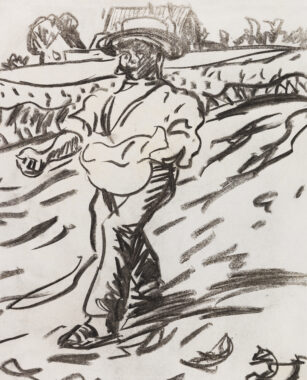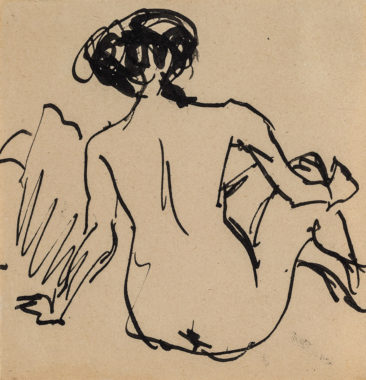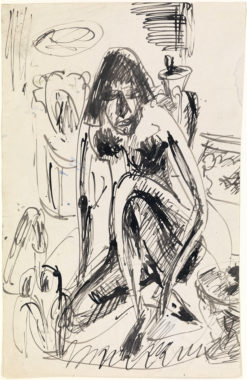Kirchner, Ernst Ludwig
Available Artworks
Sold Artworks
Biography
Ernst Ludwig Kirchner
1880 Aschaffenburg – 1938 Davos
The German Expressionist painter and printmaker Ernst Ludwig Kirchner was a founding member of the artists’ group “Die Brücke” (The Bridge) in Dresden in 1905 along with Fritz Bleyl, Erich Heckel and Karl Schmidt-Rottluff. All four were architecture students at the Königliche Technische Hochschule in Dresden. Staunchly opposed to academic tradition, they set out to create a new style of artistic expression which would pave the way for modernity – a bridge between the conservative past and a more liberal present, between the artist and society in general.
In the space of a few years “Die Brücke” became the hotbed of German Expressionism, with Kirchner emerging as its charismatic centre. Its programme of collective exhibitions, subscriptions to annual portfolios of prints and targeted media distribution brought the group increasing public recognition. Its membership expanded to include the artists Max Pechstein (1906-12), Otto Mueller (1910-13), and briefly, Emil Nolde (1906-7). It also enjoyed the support of passive members, such as the influential art historian and patron Rosa Schapire who joined in 1907.
In 1911 the group shifted its activities to Berlin, the epicentre of artistic life in Germany. But in 1913, controversy among the members led to the group’s dissolution. From then on, Kirchner distanced himself increasingly from his former colleagues, although he continued to draw on the fertile creative exchange of the Brücke years. Today, his work is widely seen as the embodiment of German Expressionism and underscores his role as a central figure in Classical Modernism.
Throughout his career Kirchner strove to develop a distinctive, independent style. He explored a variety of artistic approaches both in his printmaking and in his drawings, paintings and sculptures. Cycles of existential crisis and inner renewal shaped the stylistic shifts in his oeuvre. They mark stations in an expressive quest which spanned more than thirty years. Despite episodes of intense anxiety and repeated physical collapse he was to produce a vast body of work which is unique both in technical and aesthetic terms.
Kirchner’s main focus of interest was the representation of the human form – portraits, figurative pieces and nudes. Between 1909 and 1911, he and other members of “Die Brücke” spent part of each summer at the Moritzburg lakes near Dresden. In opposition to the constraints of bourgeois convention they advocated open sexuality and a natural state of nudity in communion with the elements. The group’s mission was to unify in their art the internal and external reality of human experience. Their common aspirations were reflected in their style and choice of motifs, many of which were centred around the study of the naked body and the figure in movement. They captured the natural poses of the models and the vitality of their movements in compelling, swiftly sketched works on paper. Driven by the same creative urge that they experienced in the studio they sketched naked bathers cavorting by the water or in the landscape. From then on, unconstrained nudity, a cipher for an awareness of life untouched by modern civilisation, was an essential source of inspiration and a constant within Kirchner’s oeuvre.
In Berlin, he immersed himself in the bustle and glare of urban life. He was particularly drawn to the vibrant night life of the city and its theatre, cafe and music hall milieu, where he would watch seedy goings-on among variety artistes and ordinary citizens out on the town. His street scenes – populated with prowling prostitutes, their faces angular and masklike, or with the contorted figures of streetwalkers, their clients and pimps – have achieved iconic status. In the summers he would retreat to the idyllic calm of the Baltic island of Fehmarn where he was often joined by fellow artists and friends.
For Kirchner, like many other artists of his generation, the outbreak of the First World War was a watershed moment. In 1915, he volunteered for military service but soon suffered a breakdown and was discharged. He spent the following year enduring bouts of psychological distress. He moved from sanatorium to sanatorium with no sign of improvement in his state of health, growing increasingly alcohol and drug dependent. But he continued to work despite his illness and produced a number of remarkable landscapes and portraits.
After a brief first stay in Davos in 1917 he resolved to leave Germany for Switzerland. By September 1918 he was living in Frauenkirch, a rural commune of Davos and in 1919, the move became permanent. A nearby farmhouse on a high plateau in the Wildboden served as his refuge, where the surrounding Alpine scenery provided new sources of inspiration. By then pain was his frequent companion and he experienced partial paralysis and periodic loss of consciousness. Landscapes, scenes from the life of the local farming community and monumental figures were his preferred themes. Although essentially objective, his work demonstrated a growing tendency towards abstraction. This was heightened by his use of simplified forms and flat areas of vibrant, unnatural colour.
When the Nazis consolidated their power in 1933, Kirchner’s art was branded as ‘degenerate’ and in 1937 hundreds of his works were detained, destroyed or systematically purged from German museums. These terrible events had a dramatic impact on his fragile psyche and intensified his existential anxieties. When Austria was annexed by Germany in March 1938 he feared an impending invasion of Switzerland by German troops. Due to the rapidly darkening political outlook he saw his situation as increasingly precarious. His nerves were shattered and he took his own life at the Wildboden farmhouse in June 1938.
PDF Download